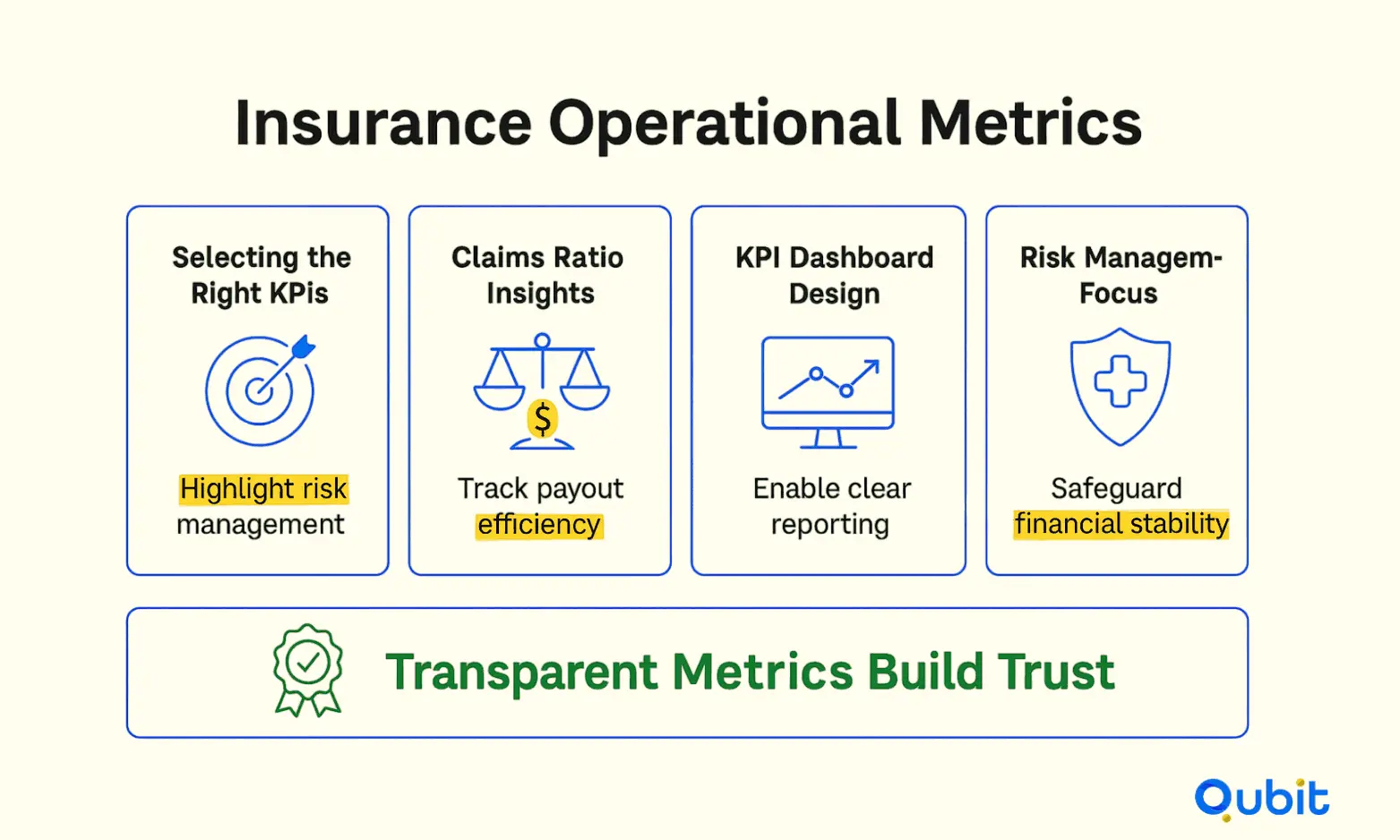With global insurtech funding in 2025 reflecting shifting investor priorities, particularly toward AI-driven solutions, startups must present data that aligns with these evolving expectations. Highlighting the dominance of AI investments early in discussions can demonstrate a forward-thinking approach, appealing to venture capitalists and lenders.
For a broader perspective on overcoming funding challenges, explore insurance startup fundraising strategies, which situates key metrics within the context of securing capital for insurance start-ups. This foundation ensures that your metrics resonate with investor priorities, paving the way for successful funding discussions.
Transparent reporting is not just a necessity, it’s a strategic advantage in attracting attention in this dynamic industry.
Insurance Operational Metrics
Operational metrics in the insurance industry serve as the backbone for evaluating performance, ensuring transparency, and driving informed decision-making. These metrics, often referred to as Key Performance Indicators (KPIs), encompass critical areas such as sales, claims, operational processes, and financial outcomes. By focusing on these metrics, insurers can maintain clarity in their operations and benchmark their performance against industry standards.

Why Selecting the Right KPIs Matters
The selection of KPIs is not just a technical exercise, it’s a strategic necessity. Carefully chosen metrics highlight an insurer’s ability to manage risks effectively, optimize loss ratios, and demonstrate overall business efficiency.
For example, tracking claims ratios provides insights into how well an insurer is managing payouts relative to premiums collected, while operational KPIs like policy renewal rates reflect customer satisfaction and retention.
Building Effective KPI Dashboards
Creating a robust KPI dashboard is essential for streamlined reporting to investors and lenders. A well-designed dashboard should:
- Prioritize clarity: Present data in an easily digestible format, avoiding unnecessary complexity.
- Focus on actionable insights: Highlight trends and anomalies that require immediate attention.
- Incorporate real-time updates: Ensure metrics are current to support timely decision-making.
By integrating these elements, insurers can provide stakeholders with a comprehensive view of their operational health, fostering confidence and trust.
The Role of Risk Management in Metrics
Risk management is a cornerstone of insurance KPIs. Metrics such as loss ratios and reserve adequacy directly reflect how effectively an insurer is mitigating risks. For instance, a low loss ratio indicates strong underwriting practices, while reserve adequacy ensures the company can meet future claims obligations. These metrics not only safeguard the insurer’s financial stability but also reassure investors and lenders of the company’s resilience.
Financial Reporting and Metrics
Financial reporting serves as the backbone of any insurtech’s operational transparency, offering a detailed narrative of its economic health. Through core financial statements such as income statements, balance sheets, and cash flow statements, businesses can provide investors and lenders with a clear picture of liquidity, profitability, and solvency. These metrics are not just numbers—they are the story of a company’s financial journey, helping stakeholders make informed decisions.
The Role of Core Financial Statements
Each financial statement plays a unique role in shaping the overall narrative:
- Income Statement: This document highlights profitability by detailing revenues, expenses, and net income over a specific period. Investors often use it to assess whether the business is generating sustainable profits.
- Balance Sheet: A snapshot of assets, liabilities, and equity, the balance sheet reveals the company’s financial position at a given moment. It’s instrumental in evaluating solvency and long-term stability.
- Cash Flow Statement: Unlike the income statement, the cash flow statement focuses on liquidity, showing how cash moves in and out of the business. This is crucial for understanding operational efficiency and ensuring the company can meet short-term obligations.
Together, these statements create a holistic economic narrative essential for evaluating the financial health of an insurtech.
Key Metrics: Gross Margin and Burn Rate
Gross margin and burn rate are two critical metrics that investors closely monitor.
- Gross Margin: This metric measures the profitability of core operations by comparing revenue to the cost of goods sold. A healthy gross margin indicates efficient operations and scalability potential.
- Burn Rate: Particularly relevant for startups, burn rate tracks how quickly a company is spending its cash reserves. Managing this metric effectively is vital for ensuring the business can sustain itself until it becomes profitable or secures additional funding.
Building Credibility Through Transparent Reporting
Transparent financial reporting is more than a regulatory requirement, it’s a trust-building tool. Investors and lenders rely on accurate, well-organized financial data to gauge the viability of a business. By presenting clear and consistent reports, insurtechs can foster confidence and attract venture capital or lending support.
The Intersection of Compliance and Financial Reporting
Reliable financial reporting is closely tied to compliance frameworks. Insurtechs must ensure their reports align with regulatory standards to maintain credibility and avoid legal pitfalls. A review of insurance compliance covenant management offers additional context by linking regulatory practices with the effective management of financial agreements.
Transparent reporting not only builds trust but also ensures that businesses remain compliant, further solidifying their reputation among stakeholders.
Customizing Reports for Venture Capitalists vs. Lenders
Venture capitalists and lenders each seek different assurances. VCs prize rapid growth, unit economics, and predictive indicators. Lenders focus on cash-flow stability, coverage ratios, and reserve adequacy.
For VCs:
- Highlight metrics like CAC, LTV, and month-over-month growth.
- Show predictive KPIs: rolling loss ratios and cohort lifetime values.
For Lenders:
- Emphasize debt service coverage ratio (DSCR) and interest coverage ratio.
- Detail liquidity metrics: current ratio and quick ratio.
- Prove reserve adequacy with runoff analyses and stress-test results.
Presentation Tips:
- Create a VC dashboard with dynamic charts for growth and runway.
- Offer lenders an executive summary plus detailed tables in appendices.
- Use consistent definitions across both to avoid confusion.
Tailoring your reports ensures each stakeholder sees the metrics they value most. This focused approach builds credibility and speeds decision-making.
Conclusion
Securing funding requires more than just numbers; it demands a compelling narrative that resonates with investors and lenders. Throughout this blog, we’ve explored strategies to enhance your reporting, from crafting clear financial summaries to presenting data in a way that tells your startup’s unique story. These approaches not only build trust but also demonstrate your business’s potential for growth.
Effective reporting is the cornerstone of attracting venture capital and loans. By focusing on clarity and storytelling, you can transform your financial data into a persuasive case for investment.
If you're ready to elevate your reporting to secure more funding, reach out to us for expert Fundraising Assistance. Let us help you turn your vision into reality.
Key Takeaways
- Transparent reporting of operational KPIs and financial statements builds investor trust.
- Effective KPI dashboards simplify data-driven decision-making.
- Clear financial narratives, including income statements and balance sheets, are key to securing funding.
- Real-world case studies illustrate how detailed metrics drive successful funding discussions.
- Automation and AI trends are transforming insurtech reporting strategies.
Frequently asked Questions
What are the key metrics for insurtech companies?
Operational KPIs such as sales performance, claims handling efficiency, and loss ratios are essential for evaluating insurtech companies. Additionally, detailed financial statements provide insights into profitability and growth potential.


 Back
Back



